Number System | Term 3 Chapter 1 | 7th Maths - Division of Decimal Numbers | 7th Maths : Term 3 Unit 1 : Number System
Chapter: 7th Maths : Term 3 Unit 1 : Number System
Division of Decimal Numbers
Operations on Decimal Numbers
Already we are familiar with decimal
numbers. We know how to represent a decimal number as a fraction and the place
values of digits. Now, let us learn the operations on decimal numbers.
Division of Decimal Numbers
A bale of shirt material consists of
24.75 m. A shop-keeper wants to make shirt bits each of 1.5 m outfit.
How many bits can be made? To find the answer, we have to divide 24.75 by 1.5.
In real life, there are many situations
where we need to divide decimal numbers.
(i) Decimal Division through
models
● Use decimal grids to find the quotient,
as you have already learnt to represent decimals in the grid form.
● Consider 2.48 in the grid form.
● To find 2.48 ÷ 2, shade grids to show
the decimal number 2.48 by Since
division means equal sharing. Seperate the shaded region into 2 equal parts as shown
below.

Here each colour represents the quotient
(i.e) 1.24.
Hence, 2.48 ÷2 = 1.24
Let us do the division of 2.48 by 2 in
the other way.
Observe the following figure.
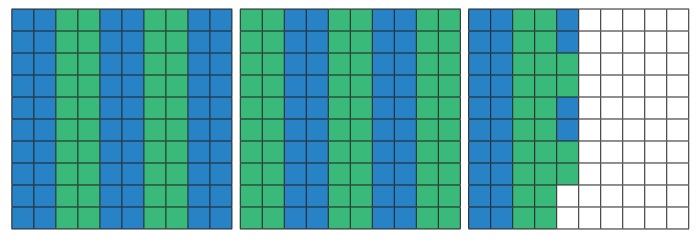
Consider 2 wholes, when you divide 2
wholes equally in groups of two’s, each group gets 5 such groups which represents
1 whole.
Next consider the tenth, taking four
tenth and dividing it in group of two’s, we get two such groups and each group represents
two tenth.
Finally, dividing 8 hundredth in group
of two’s, each group has 4 hundredth.
Therefore 2.48 ÷ 2 = 1 whole 2 tenth
4 hundredth
= 1.24.
Example 1.23
Divide 6.3 ÷ 3 using area model.
Solution
The decimal number 6.3 is shown in Fig.
1.12.

Since 6.3 is divided by 3, we seperate
the areas into 3 equal groups using three different colours as in Fig.1.13.
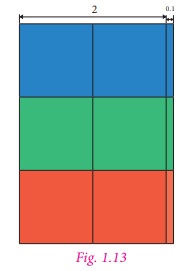
Each group to represents 2.1, which is
the quotient.
Therefore, 6.3 ÷3 = 2.1.
(ii) Division by 10, 100
and 1000
Let us learn how to divide decimal numbers
by 10, 100 and 1000.
For example, consider 51.7 ÷ 10
Now 51.7 = 517/10
Therefore, 51.7/10 = 517/10 × 517/100
= 5.17
Similarly, 51.7 ÷ 100 = 517/10 × 1/100
= 517/1000 = 0.517
Also 51.7 ÷ 1000 = 517/10 × 1/1000= 517/10000
= 0.0517
When decimal numbers are divided in powers
of 10, it can be noted that the decimal number so obtained contains the same number
of decimal digits as that of zeros in powers of 10.
Let us see whether there is a pattern
for dividing numbers by 10, 100 and 1000.
Observe the following and complete it.
Try these

Take.
36.7 ÷ 10 = 3.67. In 36.7 and 3.67, the digits are the same namely, 3, 6 and 7,
but the decimal point has been shifted to the left by one place in the obtained
decimal number after division. Note that 10 is one zero followed by 1.
Similarly, in 36.7 ÷ 100 = 0.367, the decimal point has been shifted to the left by two places in the obtained decimal number after division. Note that 100 is two zeros followed by 1.
Similarly, in 36.7 ÷ 1000 = 0.0367, the
decimal point has been shifted to the left by three places in the obtained decimal
number after division. Note that 1000 is three zeros followed by 1.
Hence we can conclude that while dividing
a decimal number by 10, 100 and 1000, the digits of the number (Dividend) and the
obtained decimal number after division are the same but the decimal point in the
obtained decimal number after division is shifted to the left by as many places
as there are zeros followed by 1.
Try these
Divide the following
(i) 17.237 ÷ 10
(ii) 17.237 ÷ 100
(iii) 17.237 ÷ 1000

Therefore, we can find 2.68 ÷
10 =
0.268 ;
2.68 ÷ 100 =
0.0268 ; 2.68 ÷ 1000 = 0.00268.
(iii) Division of a decimal
number by a whole number
Let us divide a decimal number by a whole number. Consider the following.
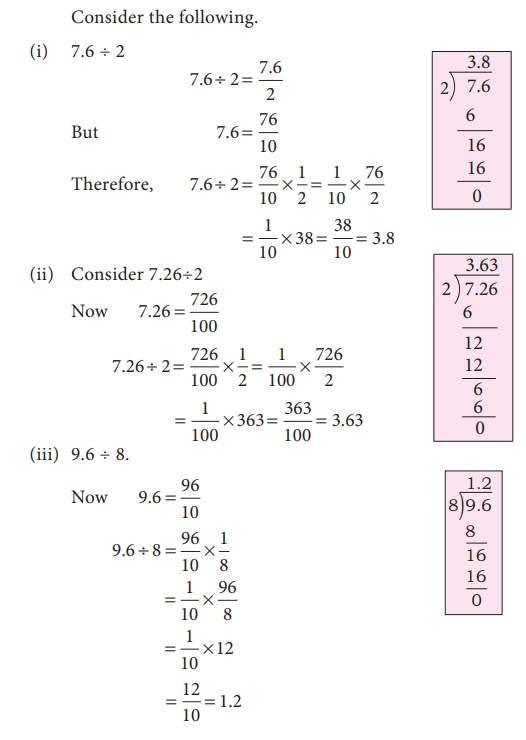
Note
We have to estimate to
check that the quotient is reasonably correct. Round 9.6 to 10 and divide by 8.
Since 8 goes into 10 once with a small reminder, the answer 1.2 is reasonably correct.
From the above three cases, we observe
that we can also divide the number without considering the decimal point first and
then the decimal point in the amount may be placed as equivalent to the decimal
digits of dividend.
For example, take 52.16 ÷ 4
Now, let us divide 5216 by 4.
5216/4 =
1304
Now there are 2 decimal digits in the
dividend. So the quotient also will have two decimal digits.
Therefore, 52.16 ÷ 4 = 13.02
Try these
Find the value of the following.
(i) 46.2÷3=?
(ii) 71.6÷ 4= ?
(iii) 23.24÷ 2= ?
(iv) 127.35 ÷ 9 = ?
(v) 47.201÷ 7 = ?
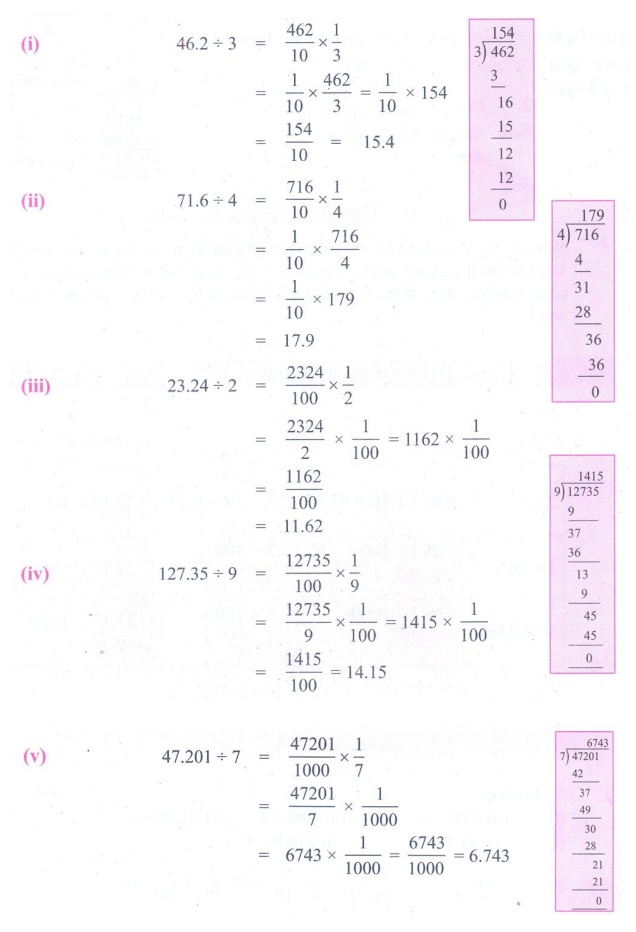
Example 1.24
Sugarcane juice of 1.5 l has to be shared equally among five members.
What is the share of each member.
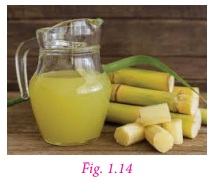
Solution
Quantity of sugarcane juice = 1.5 l
Number of persons to be shared = 5.
Individual share = 1.5/5 = 0.3 l
Therefore, the individual share is 0.3
litres.
(iv) Division of a Decimal
Number by another Decimal Number
Kavitha wants to distribute groundnut
balls to all her classmates on her birthday. She has ₹ 61.50 in her piggy bank.
If each groundnut ball costs ₹ 1.50, how many balls she can get with that amount?
In real life, there are situations in which we need to divide a decimal number by
another decimal number.

Try these
Divide the following.
(i) 9.25/0.25 (ii) 8.6/4.3 (iii) 44.1/0.21 (iv) 9.6/1.2
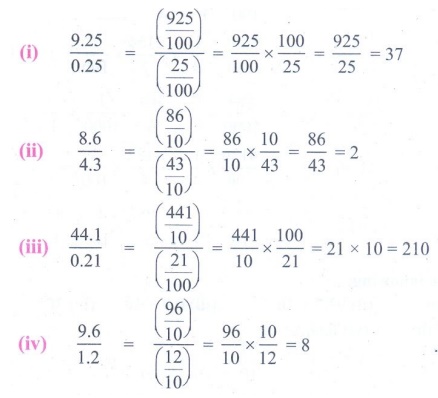
Hence, we can conclude that when both
dividend and divisor has same number of decimal digits the division is as simple
as the usual division of two natural numbers. When dividend and divisor has different
number of decimal digits, first change the divisor to a whole number by multiplying
suitable powers of 10. Then multiply the dividend by the same powers of 10.
Example 1.25
A car covers 16.8 km in 0.21 hours. What is the
distance covered by the car in one hour.
Solution
The distance covered by the car in one
hour = 16.8/0.21
Multiply the divisor by 100 to make it
a whole number. Hence multiply the dividend also by 100.
Therefore, [ 16.8 × 100 ] / [ 0.21×100]
= 1680/21 = 80.
Example 1.26
The perimeter of a regular
polygon is 17.5 cm. Each side measures 2.5 cm. Find the
number of sides of a polygon.
Solution
Since it is given that the polygon is
a regular polygon, all sides will be equal.
Therefore, the number of sides of a
polygon = perimeter / oneside
= 17.5/2.5 = 175/25
= 7 (Equal number of decimal digits in both dividend
and divisor)
Hence, the
polygon has 7 sides.
Think
The price of a tablet strip containing 30 tablets is ₹ 22.63 Then how will you find the price of each tablet?

Solution

Related Topics